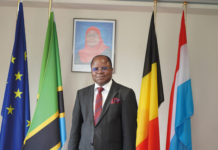Angola is resource-rich country with high reserves of oil, gas, diamonds and iron-ore, a grid of rivers with great potential for hydro-power, vast stretches of arable land, tropical climate with adequate rainfall, making it home for a much diversified fauna and flora. Situated on the south-western coast of Africa, the country has a land surface of 1 246 700 km2, which includes 1650 km coastline blessed with a rich and diverse marine life in the Atlantic Ocean. The privileged geographical location gives a strategic position as a platform for easy access to the hinterland (land-locked countries) and to the regional markets of Southern and Central Africa right up to the Gulf of Guinea.
After independence, Angola was exposed to almost 30 years of civil war with devastating consequences ranging from the massive destruction of basic infrastructure, problems in supply chain, weakness in social services, traumas suffered by the human capital and the irreparable losses that have touched almost every family. With the peace agreement reached in 2002, the country flipped the page into a new era of national reconstruction, mainly the rehabilitation of key infrastructure and the development of important integrated social programs to overturn the negative impact caused by the armed conflict.
Steady economic growth
Presently, Angola is one of the fastest growing economies in Africa, with double digits economic growth rates between 2000 and 2010 (the highest rate of 23,2% was reached in 2007). The country is a leading oil producer in Sub-Saharan Africa and is the second largest exporter of crude, right after Nigeria, with production figures of 1.8 million barrels per day.
Despite the current situation caused by the economic and financial crisis affecting international markets, the prospect for growth and development of Angola continues to be encouraging. The economy continues to grow at steady rates of 6.8% (2013), 3.9% (2014), 3.0% (2015e.) and a projected rate of 3.3 % for 2016.
Finances: recovering the credit rating
In the past two years Angola saw a slight decline of its international credit rating, given by financial institutions like Moody’s, Standard & Poor and other rating agencies. Today, there are strong signs of recovery of the financial and macroeconomic credibility of Angola in the international market, with the most recent rate of Ba2 assigned by Moody’s in October 2015, to allow the issuing of bond-tittles and treasury obligations.
Besides issuing in the domestic market, Angola is also trading in foreign markets, particularly in some recent operations to purchase Eurobonds, which indicates the confidence of the European market in the country’s financial stability and current recovery to more balanced levels. Angola has an external debt of approximately 27.6% of GDP (2014), which is comfortable position compared to some developing countries.
Another credible sign of recovery is the recent assessment by the inter-governmental body FATF-GAFI – Financial Action Task Force against Money Laundering. The evaluation was made to determine the ability of Angola to comply with the conditions necessary for combating money laundering and terrorist financing, as clarified the Ministry of Finance. This is very good for the financial system, giving Angolan banks greater access to foreign exchange with correspondent banks (cash service), thus facilitating the purchase of foreign currency which is required for international transactions.
Strengths of the Angolan market
· abundant natural resources: oil, diamonds, rich coastline, vast hydropower resources with potential for power generation, tropical climate with adequate rainfall, diversity fauna and flora, large stretches of arable land.
· adequate infrastructure for development corridors important for multimodal transport (air, land and sea)
· public investments to build and modernize economic and social infrastructure (roads and railways, ports and airports, schools and hospitals, dams and power stations,
telecommunications and energy grids, etc.).
· young workforce, very active and eager to learn (population of approximately 24,3 million people with 50% under 21) and a growing middle class
· expanding market: member-state of SADC (market with over 200 million consumers) and privileged relations with PALOPs countries (with over 250 million consumers)
· no reference of occurrences of natural disasters such as floods, earthquakes, cyclones or volcanic eruptions which may endanger human lives and resources.
What are the challenges of the Angolan market?
One of the main challenges of the Angolan market is the fact that its economy is highly dependent on revenues from the oil industry; exports of crude oil account for 97.35% of annual export´s revenues which represents nearly 46.8% of the country´s GDP (2014). Therefore, the current drop of global oil prices and the consequent decrease in revenues are causing major challenges to both private and public sector.
The country also faces problems in different areas, due to the poor development of basic infrastructure, constraints on the supply chain, bottlenecks in distribution systems, deficit supplies of water and electricity and poor provision of social services (education, health, public transport, etc.).
The need to diversify the economy
In order to minimize the country’s dependence on oil revenues, the Government launched a vast program of micro and macroeconomic reforms, aiming to create a strong and competitive market economy and promote self-sustainability through the concept of diversification.
The trade policy is aligned with the needs for development and there are different programs conceived to enhance private investment in the primary, secondary and tertiary sectors, giving full support to projects and initiatives that will boost local production and increase the contribution of non-oil sectors to the GDP. This in return will help to gradually decrease the dependence on one export product. The ultimate goal is to increase the supply of products “made in Angola” and shift the source of consumer goods from external markets (imports) to locally produced goods on the domestic market.
INVESTMENT AND BUSINESS OPPORTUNITIES
In a business perspective, the challenges and weaknesses mentioned above can be converted into opportunities for innovation and diversification; companies can look for new initiatives and whenever possible, redirect part of the resources available into new investment projects in related areas.
Private investors have unrestricted access to all sectors of the economy, including the development of key infrastructure, except in those industries classified as “sensitive”, in the areas of defense and national security, which are of the exclusive responsibility of the State.
The market offers excellent business opportunities across-the-board, for existing and future investors, mainly in the following sectors:
- Agriculture, Agribusiness and Forestry: machinery, irrigation systems, fertilizers, food-processing, selection and storage
- Fisheries: equipment and fishing gear, capture, fish processing, etc.
- Manufacturing: processing of primary products and mass production of consumer goods
- Education: tertiary education, technical and vocational training
- Healthcare: preventive medicine, pharmaceutical industry and specialized services
- Banking and financial services: insurance, introduction of new financial products, hedge-funds, compliance regulations
- ICT – information and technology: security systems, e-commerce
- Tourism: infrastructure, operations and retail services
- Widen the supply in service industry: franchising, safety and security, publishing and media services, etc.
AGRICULTURE
A promising sector
The capabilities of the agricultural sector have been proven in the colonial past for crops of sugar, cotton, rubber, coffee, sisal, corn, peanuts, potatoes, cassava, beans, fruit growing and horticulture. Back in early seventies Angola was self-sufficient in all food crops (except wheat). Two-thirds of Angolans depend on agriculture, most at a subsistence level. Maize mill, cassava and sorghum, sweet potatoes, beans, peanuts and millet are the main staples and can be grown in different regions. of rural economy during the civil war (most fields and plantations were damaged or abandoned as populations fled away, irrigation systems destroyed, crops and livestock all scattered around or stolen). With most goods currently being imported, the growth potential of the agricultural sector is enormous.
A unique climate for agriculture and livestock
Angola lies in a sub-tropical zone and yet its climate is relatively cool considering the country’s proximity to the equator. Temperatures are highest in the north, generally decreasing in further south regions. The country has two distinct seasons: warm and rainy season (October to April) and dry and cold (May to September). The climate is favorable to a wide variety of tropical and semi-tropical cultures and extensive grazing areas throughout the southwest plateau and the vast savanna. Almost half of Angola land surface is arable land with very good conditions to grow a wide variety of crops.
- The potential for cash-crops: Cash crops such as coffee, banana, sisal, sugar-cane, tobacco, cotton and palm oil have been in the main export basket, though in very small quantities due to the devastated effects of war. Before independence, Angola was the world’s fourth largest coffee producer and was also a top exporter in sugarcane, sisal, banana and cotton. In recent years, government funds have been earmarked for the coffee sector and in 2007 the CFC (Common Fund for Commodities) granted USD 8.5 million to help revive a thriving industry once famous for its Robusta coffee-beans.
- Rearing livestock: Much of Angola’s farming is based on grazing livestock across pastureland and this is generally an activity of subsistence. Cattle herding is an important activity rural areas and after the cereals (maize, cassava, sorghum) beef is the second largest agricultural product in the country. Other livestock, such as goats, pigs and poultry are kept mainly by small-holders for their subsistence farming.
- Forestry: Despite the expansion of subsistence farming, logging and demand for fuel wood, the country has relatively low deforestation rates. Timber resources remain significant with tropical forests containing valuable trees such as rosewood, ebony and African sandalwood. Angola also has large areas of eucalyptus and pine (The Benguela Railway Company had the biggest forest of eucalyptus in Africa).
Opportunities in Agriculture
Opportunities in Angola’s agriculture sector are plentiful as the government seeks to increase production levels for internal consumption and relaunch Angola’s exports. In fact, the agriculture is seen as a top priority for the Government, as it has huge potential to attract inward investment and generate significant revenues.
To supply the local market and reduce imports, the Government is making huge investments in agriculture and is encouraging private investors to follow the same route, thus improving the livelihoods in rural zones and guaranty safe levels of food security.
Private projects as well as inter-governmental project proposals are welcomed, especially in the following areas:
- Manufacturing and food-processing – supply of equipment like juice-makers, mills, packaging and storage gear, etc.
- Construction, rehabilitation of farming infrastructure, including storing capacity, distribution chains and refrigeration solutions
- Industrial and agricultural machinery and equipment, complemented by technical assistance
- Support to the production of seeds, pesticides and soil fertilizers,
- Expansion of poultry and fish farming
- Provision of training in general agri-business skills
- Provision of higher education formation
- Rural micro-credit and micro-finances, including insurance against risks of natural disasters that may affect crops and harvests
- Technology and technical support to farming activities, irrigation, cross-breeding, etc.
- Support agricultural study and research centers
FISHERIES
- A fishing nation: Angola is in the top ten African producers of fish (not including stocks raised on fish farms) and is currently in the process of re-establishing its fishing industry and processing facilities. The rich fishing shores of Angola are due to the nutrient-rich cold waters of the Benguela The prevailing winds produce upwelling of water with a cool temperature, relatively low salinity and a high concentration of plankton, creating excellent fishing grounds. Catches of sardines, tuna, mackerel and hake, as well as prawns, lobsters and crabs, are the most popular.
Opportunities in fisheries and fishing industry
- Construction and rehabilitation of fishing factories
- Opening of storage and processing facilities
- Construction of shipyards for maintenance and repairs
- Naval construction and engineering
- Machinery, equipment and industry-related power-tools
- Transport and logistics: cooling trucks, cold-rooms, ice-factories
- Aquaculture and fish-farming
TOURISM AND HOSPITALITY
The geography and tropical climate of Angola, its rich fauna and diverse flora are just some of the attractive conditions for tourism and adventure. Beautiful landscape, clean and sandy beaches, clear skies and crystalline waters from rivers, lakes, fresh streams and waterfalls are many of the natural wonders waiting to be explored by the connoisseur. There’s also a cultural diversity from music and dancing rituals to handcrafts and the traditional cuisine of the different ethnic groups.
Opportunities in tourism and hospitality industry
In Angola, the big bulk of tourism revenue comes from business tourism, so the market for accommodation has still room to grow. The country counts only with 183 hotels, making less than 20 000 beds. Therefore, opportunities to invest in tourism and hospitality industry are plenty for both construction and operations of facilities like:
- Hotels and conference centers
- Holidays resorts in land and on the seaside
- Establishment of parks, reserves and conservation areas
- Promotion of rural tourism and outdoors
- Tour operators for tailor made packages
- Facilities for business tourism (excursions, team-building)
Tourism in SADC region
The regional integration of Southern Africa as a single market is well advanced and along with other member-states, Angola is both promoter and beneficiary of SADC strategy to integrate the tourism sector.
The Regional Infrastructure Strategic Development Plan of SADC (RISDP) has proposed the creation of TransFrontier Conservation Areas as means to promote tourism and ensure conservation of biodiversity.
INFRASTRUCTURE DEVELOPMENT
After nearly three decades of civil war, where over 70% of the country’s infrastructure was destroyed, Angola has made enormous progress in rehabilitating its infrastructure networks. Over the past decade, strong government commitment propelled infrastructure development, sustained by revenue streams from mineral exports and a peaceful environment that has attracted significant private investments.
Addressing infrastructure constraints in transport, water and electricity supply, transport networks and social facilities will go a long way. In this front, private investors are invited to support the government’s economic diversification efforts, which should have positive spill-over effects on the wider economy.
Public-Private Partnerships in infrastructure development
Angola’s infrastructure spending has significantly increased over the past few years. However, cuts in 2015 and 2016 budgets led to some scaling back, with certain projects being delayed. As a result, the Government is looking for more inward investment along with Public Private Partnerships (PPP) mechanisms.
Huge investments have been injected into roads and railways. Clean, renewable hydroelectric facilities are gradually extending the power network across the country. Significant investments have also been injected into housing projects in all provinces. This segment will continue to attract investors in mid-term on the sector and related services (maintenance, building management, mortgage loans, etc.).
The main areas for growth and development of infrastructure projects include:
- Construction and engineering: construction and public works, equipment, building materials
- Infrastructure development and operations:, communications, etc.
- New ports, dams, airports, construction and maintenance secondary roads, etc.
- Energy – power generation and distribution, biofuels, equipment,
- Mining: machinery and equipment for small scale mining companies
- Improving public services
- Improving transport links across the country and develop platforms for logistics and maintenance service
- Luanda 2030’ – an ambitious plan to make Luanda a 21st century capital with new road systems, trams, etc.
Opportunities in infrastructure development
Among other areas, private investors and companies are invited to look for opportunities and seek projects that include:
- Architecture and engineering design
- Manpower development and training in transport and logistics (operations in rail subsector, naval construction, mechanical engineering, etc.)
- Warehousing, haulage and logistics, services for loading and offloading goods
- Social housing and communitarian buildings
- Water treatment service and efficient distribution
- Energy grids on the distribution side
- Renewable – green energy especially for rural areas
![[:fr]Screen-Shot-2016-03-29-at-19.26.55-300x200[:]](https://perspectives-cblacp.eu/wp-content/uploads/2016/03/Screen-Shot-2016-03-29-at-19.26.55-300x200-1.png)


